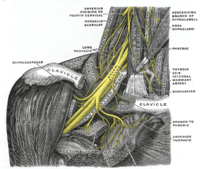
Photo from wikipedia
BACKGROUND Variations in the axillary nerve branching patterns have been reported. The aim of the study is to investigate the extra- and intra-muscular course of the axillary nerve and quantify… Click to show full abstract
BACKGROUND Variations in the axillary nerve branching patterns have been reported. The aim of the study is to investigate the extra- and intra-muscular course of the axillary nerve and quantify the regional innervation of the deltoid. METHODS In fresh frozen specimens, the origin of the axillary nerve from the posterior cord of the brachial plexus and its extra- and intra-muscular course were identified. Muscle dimensions, branching patterns and the distance from the axillary nerve origin to major branches were measured. The weights of muscle segments supplied by major branches of the axillary nerve were recorded. RESULTS Twenty-three cadaveric dissections were completed. The axillary nerve bifurcated within the quadrangular space in all cases. The mean distance from the origin to bifurcation of the axillary nerve was 39 ± 13 mm; from axillary nerve bifurcation to the teres minor branch was 13 ± 6 mm; and from axillary nerve bifurcation to the middle branch of anterior division was 26 ± 11 mm. The nerve to teres minor and superior lateral brachial cutaneous nerve originated from the posterior division or common trunk in all cases. No fibrous raphe were identified separating anterior, middle and posterior deltoid segments. The anterior division of axillary nerve supplied 85 ± 4% of the deltoid muscle (by weight). The posterior division supplied 15 ± 4% of the deltoid muscle (by weight). The posterior deltoid was supplied by both anterior and posterior divisions in 91.3% of cases. CONCLUSIONS This study demonstrates a consistent branching pattern of the axillary nerve. The anterior division of the axillary nerve innervates all three deltoid segments in most instances (85% of the deltoid by weight). This study supports the concept of re-innervation of the anterior division alone in isolated axillary nerve injuries.
Journal Title: The journal of hand surgery Asian-Pacific volume
Year Published: 2018
Link to full text (if available)
Share on Social Media: Sign Up to like & get
recommendations!